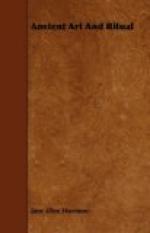Now is this art or ritual? It is both and neither. We distinguish between a form of prayer and a work of art and count them in no danger of confusion; but the Huichol goes back to that earlier thing, a presentation. He utters, expresses his thought about the sun and his emotion about the sun and his relation to the sun, and if “prayer is the soul’s sincere desire” he has painted a prayer. It is not a little curious that the same notion comes out in the old Greek word for “prayer,” euche. The Greek, when he wanted help in trouble from the “Saviours,” the Dioscuri, carved a picture of them, and, if he was a sailor, added a ship. Underneath he inscribed the word euche. It was not to begin with a “vow” paid, it was a presentation of his strong inner desire, it was a sculptured prayer.
Ritual then involves imitation; but does not arise out of it. It desires to recreate an emotion, not to reproduce an object. A rite is, indeed, we shall later see (p. 42), a sort of stereotyped action, not really practical, but yet not wholly cut loose from practice, a reminiscence or an anticipation of actual practical doing; it is fitly, though not quite correctly, called by the Greeks a dromenon, “a thing done.”
At the bottom of art, as its motive power and its mainspring, lies, not the wish to copy Nature or even improve on her—the Huichol Indian does not vainly expend his energies on an effort so fruitless—but rather an impulse shared by art with ritual, the desire, that is, to utter, to give out a strongly felt emotion or desire by representing, by making or doing or enriching the object or act desired. The common source of the art and ritual of Osiris is the intense, world-wide desire that the life of Nature which seemed dead should live again. This common emotional factor it is that makes art and ritual in their beginnings well-nigh indistinguishable. Both, to begin with, copy an act, but not at first for the sake of the copy. Only when the emotion dies down and is forgotten does the copy become an end in itself, a mere mimicry.
It is this downward path, this sinking of making to mimicry, that makes us now-a-days think of ritual as a dull and formal thing. Because a rite has ceased to be believed in, it does not in the least follow that it will cease to be done. We have to reckon with all the huge forces of habit. The motor nerves, once set in one direction, given the slightest impulse tend always to repeat the same reaction. We mimic not only others but ourselves mechanically, even after all emotion proper to the act is dead; and then because mimicry has a certain ingenious charm, it becomes an end in itself for ritual, even for art.
* * * * *
It is not easy, as we saw, to classify the Huichol prayer-disks. As prayers they are ritual, as surfaces decorated they are specimens of primitive art. In the next chapter we shall have to consider a kind of ceremony very instructive for our point, but again not very easy to classify—the pantomimic dances which are, almost all over the world, so striking a feature in savage social and religious life. Are they to be classed as ritual or art?




